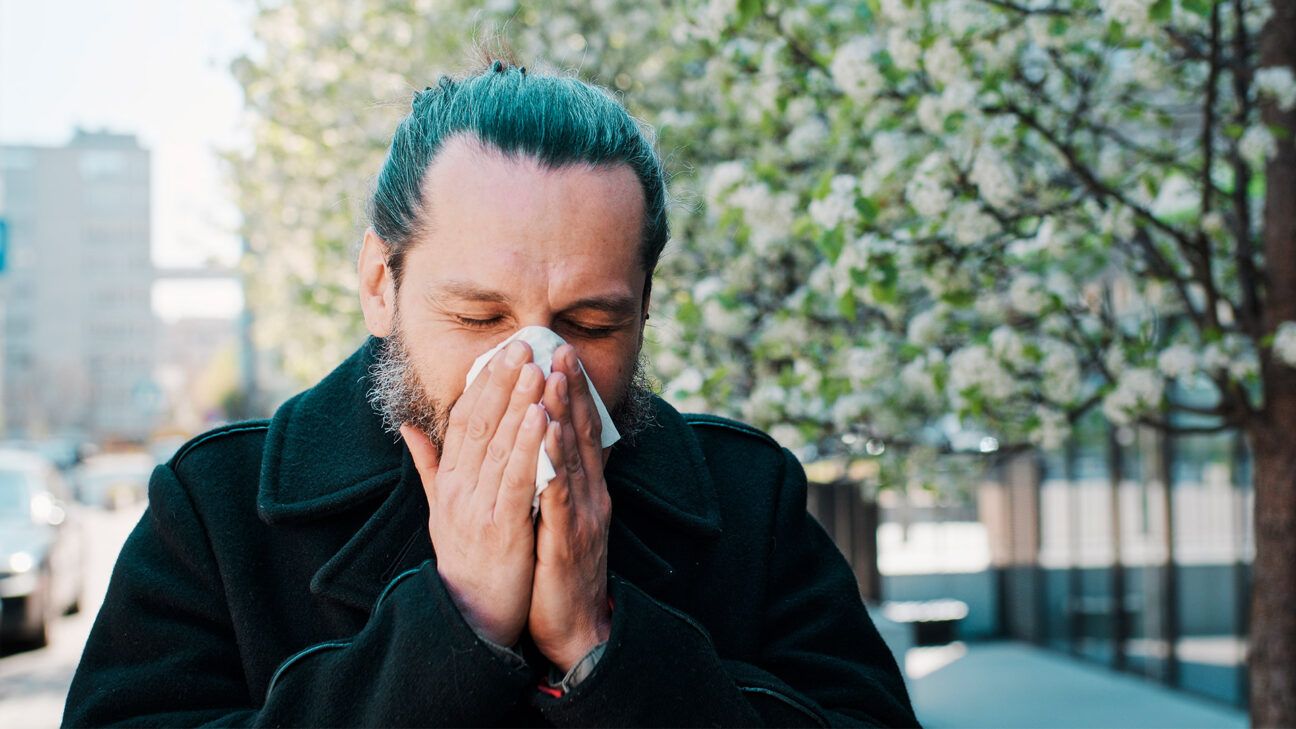Expert advice says to wake up with headaches, which can set a…
Content source – www.soundhealthandlastingwealth.com

As we bid farewell to peak cold and flu season, another wave of sniffles and sneezes is taking over, courtesy of spring allergies.
Seasonal allergies, which range from hay fever to allergic rhinitis and pollen allergies, seem to be arriving with greater intensity and lingering longer year after year. And no, you’re not imagining it.
In some parts of North America, allergy seasons have been extended up to three weeks.
Public health and research organizations like the Centers for Disease Control and Prevention (CDC) and the Asthma and Allergy Foundation of America point to climate change as a possible contributing factor to worsening allergy seasons.
With warmer air temperatures, pollinating plants may experience earlier and longer growing seasons, allowing them to produce more pollen.
“Climate change impacts allergy season because the consistent rhythm of, in the case of pollen, for example, new flowers being generated through Spring is all off kilter. Areas that were not pollinating at a given time are pollinating earlier, while other areas are pollinating later,” Frederic Bertley, PhD, president and CEO of the Center of Science and Industry (COSI), told Healthline.
“The trend we are seeing in recent years is an increase in allergic responses in individuals, generally speaking, and an increase in allergic responses by age,” he added.
More than a quarter of adults and about 1 in 5 children experience seasonal allergies in the United States.
All that coughing and wheezing comes with a price tag, too: current estimates put pollen-related medical expenses at more than $3 billion annually.
But, even with a worse allergy season, there are actionable strategies you can follow to decrease your pollen exposure and reduce your risk of allergies. Here’s your guide to staying sniffle-free and enjoying spring this year.
Limiting your exposure to pollen is the best way to prevent symptoms during allergy season. This means keeping your home clear of pollen while you’re inside.
Close doors and windows during allergy season to physically keep pollen from entering your home.
“Sometimes that is frustrating because we like the breeze from opening a window, but the fact of the matter is that if you open a window, the pollen and other antigens/allergens will come in from the outside and be inside your home,” said Bertley.
If possible, utilize HEPA filters on your HVAC system or air conditioning unit to keep pollen and other potential allergens such as mold out of your home.
A little “spring cleaning” can go a long way to help reduce allergens in your home. “Try to keep as clean as possible and try to be as dust-free as possible,” said Bertley.
Take time to dust and clean the house: Dust and dander around the home are bound to contain pollen and other allergens.
If you’re a pet owner, it might be time to bathe your furry friend. Not only can pets trigger specific allergies from their dander, but they can also bring pollen into the home.
This one is a no-brainer for anyone who came away from cold and flu season unscathed.
Like viruses, pollen is likely to be on your hands. Washing your hands frequently can prevent it from getting to sensitive areas like your eyes, mouth, nose, and throat.
If you plan to be outside regularly or engage in outdoor activities during allergy season, your chances of exposure to pollen are higher. Still, you can take a few precautions to help limit your exposure to pollen.
Local and regional weather services regularly forecast pollen levels in the air. If you will be outside, track weather and pollen levels to limit exposure.
The Weather Channel provides a 15-day allergy forecast for tree, grass, and ragweed pollen.
If you’ve spent the day outside, your clothes will likely carry pollen back inside with you. Take a shower to remove pollen from your hair and body.
Consider washing your clothes immediately or storing them separately from other items to limit pollen spread.
If you have a severe allergic reaction to seasonal pollen, don’t risk going outside, especially if pollen levels are high.
“As much as we love Mother Nature, if you are very allergic to the things that Mother Nature provides, stay out of Mother Nature as best as possible until the season changes,” said Bertley.
In addition to prevention, there are many options for allergy relief from your doctor and local pharmacy.
Over-the-counter allergy medications include:
Stronger prescription versions of these types and of other drugs are also available through your doctor.
If spring allergies are preventing you from functioning normally, you should seek advice from your healthcare team.
For severe allergy symptoms, allergen immunotherapy or “allergy shots” could also be an option.
Allergy immunotherapy is a series of treatments in which an allergen is gradually introduced to the body to build up immunity to it.
While it is possible to experience pollen-related allergies throughout the year, they are most commonly associated with the seasons when specific plants are pollinating, leading to high levels of pollen in the air.
“Allergies occur as an abnormal response to something normally occurring in the environment, specifically protein fragments from tree pollen in the spring, grass pollen in the summer, and weeds in the winter,” Tania Elliott, MD, a spokesperson for the American College of Allergy, Asthma and Immunology, told Healthline.
Everyone responds to allergens differently, so you could be allergic to grass pollen but not tree pollen or ragweed.
The term “hay fever,” or allergic rhinitis, refers to an allergic reaction to pollens released from trees, grasses, and other vegetation, which causes cold-like symptoms.
Some common symptoms of seasonal allergies include:
Seasonal allergies seem to last longer and be more severe than in years prior.
Experts believe climate change may affect seasonal allergies due to lengthening growing seasons.
You can take actionable steps to limit pollen exposure during allergy season. These include frequent handwashing, keeping doors and windows closed, checking daily pollen levels, and considering OTC or prescribed medications for relief.
Why Spring Allergies Are Expected to Be Longer, Stronger This Year Read More »

Chewing gum can release hundreds to thousands of microplastics into the saliva that may be ingested.
Research presented this week at the spring meeting of the American Chemical Society in San Diego, CA, found that, on average, 100 microplastics were released per gram of chewing gum. The research has not yet been published in a peer-reviewed journal.
“Our goal is not to alarm anybody,” Sanjay Mohanty, PhD, the project’s principal investigator and an engineering professor at the University of California, Los Angeles (UCLA), said in a press statement.
“Scientists don’t know if microplastics are unsafe to us or not. There are no human trials. But we know we are exposed to plastics in everyday life, and that’s what we wanted to examine here.”
Past research estimates that an individual consumes between 39,000 and 52,000 particles of microplastics annually.
Microplastics are everywhere, and humans may be exposed to them through drinks, foods, plastic packaging, chopping boards, sponges, coatings on products, and the manufacturing process of items.
Chewing gum is one area that hasn’t been widely researched.
“My lab has done work mainly on microplastic transport in water and soil and their fate in soil. We learned different ways one can be exposed to microplastics: ingestion and inhalation,” Mohanty told Healthline.
“Most of the ingestion studies related to food are [about the] contamination of food with microplastic from plastic containers (e.g., plastic water bottles, plastic tea bags), but chewing gum is the only food that is made up of plastics. Yet, most don’t know. We wanted to measure microplastics in chewing gum. This is important to estimate total microplastic exposure into the human body and any possible negative effects,” Mohanty continued.
Chewing gum is made with flavoring, sweetener, a rubber base, and other ingredients.
In chewing gums that are “natural,” a plant-based polymer, like tree sap, gives the gum chewiness. Synthetic rubber bases from a petroleum-based polymer (plastic) are used for synthetic gums.
The researchers examined five types of synthetic gum along with five types of natural gum that are commercially available.
As part of the experiment, one person chewed seven pieces of gum from each brand to account for varied chewing patterns and saliva.
The person chewed the gum for four minutes and produced a saliva sample every 30 seconds. They then rinsed their mouth with clean water. The saliva samples were then combined into one sample.
In a different experiment, saliva samples were collected every 20 minutes.
The researchers then measured the amount of microplastics present in the saliva samples.
The researchers initially suspected that synthetic forms of chewing gum would contain more microplastics but were surprised to find natural chewing gums also contained a similar amount of microplastics.
“We were not surprised to find microplastics in chewing gum but we are surprised to find them equal amount in both synthetic and organic gum. We assumed organic one should have less than that of synthetic… We are perplexed by the source of microplastics in them (natural gums),” Mohanty said.
The researchers found an average of 100 microplastics were released for every gram of gum.
Some pieces of gum produce up to 600 microplastics per gram. For context, the researchers note that a single piece of gum typically weighs 2–6 grams.
The researchers also found that both the synthetic and natural gums contained the same kind of polymers, the highest amount were of polyolefins, a type of plastic that includes polyethylene and polypropylene.
Tracey Woodruff, PhD, a professor of obstetrics and gynecology at UCSF who has studied the health impacts of microplastics, said the fact chewing gum contains microplastics isn’t entirely surprising. Woodruff wasn’t involved in the study.
“Nothing surprises me about how many places plastic is anymore, but it is sad and surprising in the fact that these things that are in our food or putting in our mouth, sometimes, for a long time, could be releasing microplastics,” she told Healthline.
“We already know we’re exposed to lots of different micro plastics… because they’ve been measured in every part of the body… But the problem is, is that the gum that you’re chewing is adding on to all the other microplastic exposure you’re already getting.”
The health impacts of microplastics on humans are still the subject of ongoing research.
One 2024 review found that microplastics were suspected to harm human respiratory health, digestive health and reproductive health and were also possibly associated with colon and lung cancer.
Dana Hunnes, PhD, a senior clinical dietitian at UCLA Health, told Healthline that despite knowing that microplastics are widespread, the findings of the study are still shocking. Hunnes wasn’t involved in the study.
“I honestly never would have thought to even think about chewing gum as a source of microplastics! Yes, I am very surprised with this study, and not pleasantly so. When chewing gum, most people tend to swallow their saliva, so if chewing gum is releasing microplastics into saliva that people are swallowing, that’s not great,” she told Healthline.
Hunnes noted that some people may prefer to reduce their use of chewing gum or stop chewing gum altogether.
“This article indicated that both natural and manufactured chewing gums contained similar amounts of microplastics, so, in that case, it likely doesn’t much matter which they’re chewing. It might be best to stop or at least decrease the frequency. Especially for children [with] developing and more-susceptible brains to these chemicals causing damage,” Hunnes said.
Woodruff said chewing gum is a personal choice, but her own preference is to refrain from chewing gum.
“The more you chew, the more micro plastics you’re going to expose yourself to. And the other component of this is you’re adding plastics to already existing, ongoing plastic exposure. So my own preference would be to not chew chewing gum,” she said.
“If people are interested in lowering their exposures to microplastics, which we know are linked to certain types of health effects, not consuming chewing gum would be an option to avoid microplastic exposures.”
Chewing Gum Could Release Thousands of Microplastics Into Saliva, Study Finds Read More »
Details of who is eligible to book a free NHS COVID-19 vaccination this spring.
Who’s eligible for the 2025 COVID-19 vaccine, or ‘Spring Booster’? Read More »
Today we have published a Priority Pathogen Families reference tool, highlighting 24 pathogen families where we believe further research is most needed in the interests of biosecurity.
Priority Pathogens: The disease families which require urgent scientific research Read More »

The links between blood pressure, diet, exercise, or smoking and heart disease risk have been well established.
Yet new research indicates these risk factors may significantly impact women’s heart health more than men’s.
The findings, being presented at the American College of Cardiology’s Annual Scientific Session (ACC.25) on March 29-31 in Chicago, suggest that a person’s sex should be considered during routine screenings, which could provide a clearer assessment of cardiovascular risk.
Researchers say understanding sex-based differences in heart disease risk factors could also help inspire people to make heart-healthy changes. The research has not yet been published in a peer-reviewed journal.
The researchers examined data from over 175,000 adults who participated in the Ontario Health Study between 2009 and 2017, with females making up 60% of the group.
At the start of the study, none of the participants had been diagnosed with heart disease. The study focused on eight established cardiovascular risk factors:
Each participant received an assessment for these factors and was categorized as having either ideal or poor health in each category.
Using these individual classifications, the researchers created an overall health profile, ranking participants as having poor, intermediate, or ideal cardiovascular health depending on the number of positive and negative risk factors they exhibited.
Follow-up evaluations occurred over a median period of just over 11 years. The study tracked major cardiovascular events such as:
Findings showed that females tended to have more favorable risk profiles than males. They were more likely to maintain an ideal overall health status, with 9.1% achieving a perfect score across all eight factors, compared to only 4.8% of males.
Conversely, fewer women (21.9%) fell into the poor health category compared to males (30.5%).
Regarding specific risk factors, females were more likely than males to have optimal diet, blood glucose, cholesterol, and blood pressure levels. However, they were slightly less likely to reach ideal physical activity levels.
Despite having generally better health metrics, females who did accumulate more negative risk factors faced a significantly higher risk of severe cardiovascular events than males with comparable risk profiles.
After adjusting for age, the data revealed that both males and females with poor or intermediate cardiovascular health were at greater risk for heart disease compared to those in ideal health. However, the impact was more pronounced in females.
Females classified as having poor health faced nearly five times the risk of heart disease compared to those with ideal health, whereas males with poor health had 2.5 times the risk.
Females in the intermediate health group had 2.3 times the risk, while their male counterparts had 1.6 times the risk.
The researchers emphasized the need for further investigation to determine how biological and sociocultural factors may contribute to these differences in cardiovascular outcomes between males and females.
They also plan to analyze whether the effects of risk factors vary across racial and ethnic groups or in females before and after menopause.
While the study itself couldn’t explain why sex-based differences appear to impact cardiovascular risk, Daniel Atkinson, MD, clinical lead at Treated, suggested a few reasons behind this phenomenon. Atkinson wasn’t involved in the study.
“It’s not fully understood why this is the case, but some research has suggested it might be because of physiological differences between men and women,” Atkinson said.
“Outdated approaches to managing heart disease in women might also be contributing to the issue because, as the study points out, screenings are rarely gender specific,” he noted.
“Heart disease symptoms might present differently in women and could manifest differently at specific stages in their life if hormonal changes do impact things,” Atkinson continued.
Atkinson added that while hormonal birth control doesn’t cause heart disease, some types can trigger high blood pressure or cholesterol, which might contribute to a greater risk in females who already have other cardiovascular risk factors.
Rohit Vuppuluri, DO, an interventional and vascular cardiologist at Chicago Heart & Vascular Specialists, told Healthline it’s “important for women to understand that although cardiovascular disease is higher in men, cardiovascular disease is still a leading cause of death for both women and men.”
However, women are often underdiagnosed, he said, because their symptoms are atypical.
According to the American College of Cardiology, while both females and males exhibit the more typical heart attack symptom of chest pain, females are more likely to experience additional symptoms such as nausea and shortness of breath.
“After menopause, women can have [a] greater risk of cardiovascular disease, and close monitoring of risk factors should occur for women as they become older,” said Vuppuluri.
This includes doing regular blood pressure checks, cholesterol testing, and glucose monitoring.
“Women must also be proactive in managing their lifestyle,” he advised.
Jayne Morgan, MD, a cardiologist and vice president of medical affairs at Hello Heart, pointed to several lifestyle factors that females should seek to manage to promote cardiovascular health. Morgan wasn’t involved in the study.
Finally, Morgan noted the importance of being aware that women’s heart disease risk rises during perimenopause. She suggested speaking with your physician about any additional steps you may take to protect your heart.
Women’s Heart Health More Affected by Lifestyle Risks Than Men, Study Finds Read More »